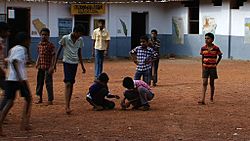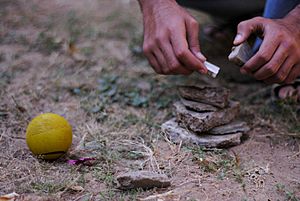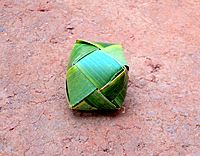Seven stones facts for kids
Seven Stones, also called Lagori or Pithu Garam, is a super fun outdoor game. It comes from the Indian subcontinent. You play it with a ball and a stack of flat stones. Two teams compete in a big open space. It's still a popular game in many villages today!
Contents
How to Play Seven Stones
This game is played by two teams. One team is called the seekers, and the other is the hitters.
Starting the Game
- A player from the seekers team throws a ball at a stack of stones.
- The goal is to knock the stones over!
- After the stones fall, the seekers try to stack them back up.
- But wait! The hitters try to hit the seekers with the ball.
- If a seeker gets hit by the ball, they are out of the game.
- The seekers team keeps playing, even if a player is out.
- A seeker can be safe if they touch a hitter before the ball hits them.
Important Rules
- The player throwing the ball must stand behind a special line. They can't get too close to the stones.
- If a player tries to knock down the stones three times and fails, they are out.
- If the thrower misses the stones and an opponent catches the ball after it bounces once, the thrower is out.
- Both teams must have the same number of players.
- The stack usually has 7 or 5 flat stones.
- Hitters cannot run while holding the ball to hit a seeker.
- Once the seekers successfully stack the stones, they shout the game's name. This tells everyone the pile is rebuilt!
Other Names for the Game
This game has many different names across India:
- Pithu garam in Punjab and Himachal Pradesh.
- Lagori in Karnataka.
- Lingoj in Telangana.
- Lingorcha, Lagori, or Seven Tilo in Maharashtra.
- Pitto or Pittu in Haryana, Uttarakhand, Uttar Pradesh, northern Rajasthan, and West Bengal.
- Sitoliya in Rajasthan, Bihar, and Madhya Pradesh.
- Satodiyu in Gujarat.
- Bam Pitto or Pittu in Bihar.
- Yedu penkulata, Yedu rallu, dikori, or pittu in Andhra Pradesh.
- Palli Patti in Karimnagar.
- Dabba kali in Kerala, sometimes played with a ball made of coconut leaves called "olapanthu".
- Ezhu kallu in Tamil Nadu.
- Garmaan, Garam, Minto in Kashmir.
- Basketgoal in Odisha.
People in other countries also play similar games with different names:
- Haft Sang in Iran.
- Sat Chara in Bangladesh.
- Pitho Garam, Pitthu Garam, Pitthu Gol Garam, Pittu Garam, or Pittu Gol Garam in Pakistan.
- Cantracon in Afghanistan.
Lagori Today
Not long ago, kids everywhere played many outdoor games. Football and cricket were popular. But old Indian games like Kabaddi, Kho-Kho, and Gilli Danda were also played.
Over time, many of these traditional games started to disappear. But some, like Kabaddi, became super popular again. The Pro Kabaddi League helped make it a global hit. Lagori, which was also a favorite in the past, is now becoming popular worldwide too!
Lagori Goes Global
Today, Lagori is played in at least 30 countries. It's becoming well-known around the world. India is a big center for growing the game. The Indian Lagori Premier League (ILPL) in 2017 was a huge success. The Amateur Lagori Federation of India helped make it happen. They are working hard to spread the game in India and other countries. The second Lagori World Cup is happening soon. Many nations like India, Bhutan, Hong Kong, Brazil, Turkey, Sri Lanka, Bangladesh, and Nepal will compete.
Modern Game Changes
The basic rules of Lagori haven't changed much. But how the game is played has seen some updates. The International Lagori Foundation set new guidelines:
- Each team has 12 players.
- Only 6 players are on the court for each set.
- One set lasts for 3 minutes, with a short break.
- A match usually has 3 sets.
- The team with the most points wins.
The game has really changed from its old days. It used to be played on a dusty field with random stones. Now, it's played on indoor courts with special fiber discs. Instead of an old tennis ball, they use a soft ball made just for the game.
Lagori was almost forgotten for a while. But with the first World Cup in 2015 and the Indian Lagori Premiere League, it's making a big comeback!
Lagori in Movies and TV
- In the TV show TVF Triplings, a game of SPL (Sitoliya Pitto Lagori) helps bring a family together.




